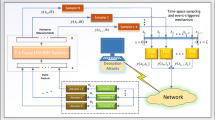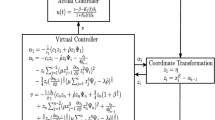Abstract
This paper addresses mixed \(H_2/H_\infty\) fault-tolerant sampled-data (SD) fuzzy control for nonlinear space-varying parabolic partial differential equation (PDE) system under deception attacks. Firstly, a T–S fuzzy PDE model is given to exactly describe the nonlinear space-varying parabolic PDE system. Secondly, a fault-tolerant SD fuzzy controller via the spatial linear matrix inequalities (SLMIs) is developed based on a Lyapunov functional which is continuous at sampling times but not necessary to be positive definite in sampling intervals such that the closed-loop PDE system is exponentially stable with a mixed \(H_2/H_\infty\) performance. Then, to solve the SLMIs, the fault-tolerant SD fuzzy control problem for space-varying parabolic PDE system is formulated as linear matrix inequality feasibility problem. Furthermore, the design condition of the suboptimal mixed \(H_2/H_\infty\) fault-tolerant SD controller subject to deception attacks can be derived by considering the property of membership functions. Lastly, two examples are given to illustrate the design method.








Similar content being viewed by others
References
Ray, W.-H.: Advanced Process Control. McGraw-Hill, New York (1981)
Li, H.-X., Deng, H., Zhong, J.: Model-based integration of control and supervision for one kind of curing process. IEEE Trans. Electron. Packag. Manuf. 27(3), 177–186 (2004)
Christofides, P.-D.: Nonlinear and Robust Control of PDE Systems: Methods and Applications to Transport-Reaction Processes. Birkhäser, Boston (2001)
Hagen, G., Mezic, I., Bamieh, B.: Distributed control design for parabolic evolution equations: application to compressor stall control. IEEE Trans. Autom. Control 49(8), 1247–1258 (2004)
Demetriou, M.A.: Guidance of mobile actuator-plus-sensor networks for improved control and estimation of distributed parameter systems. IEEE Trans. Autom. Control 55(7), 1570–1584 (2010)
Smyshlyaev, A., Krstic, M.: Adaptive Control of Parabolic PDEs. Princeton University Press, Princeton, NJ (2010)
Ho, S.-J., Chen, B.-S.: Robust fuzzy \(H_\infty\) estimator-based stabilization design for nonlinear parabolic partial differential systems with different boundary conditions. IEEE Trans. Fuzzy Syst. 24(1), 208–222 (2015)
Wang, J.-W., Wu, H.-N., Yu, Y., Sun, C.-Y.: Mixed \(H_2/H_\infty\) fuzzy proportional-spatial integral control design for a class of nonlinear distributed parameter systems. Fuzzy Sets Syst. 306, 26–47 (2017)
Zhang, X.-W., Wu, H.-N., Wang, J.-W.: Mixed \(H_2/H_\infty\) fuzzy control plus mobile actuator/sensor guidance for semilinear parabolic distributed parameter systems. IEEE Trans. Fuzzy Syst. 29(7), 1874–1884 (2021)
Wang, Z.-P., Wu, H.-N.: On fuzzy sampled-data control of chaotic systems via a time-dependent Lyapunov functional approach. IEEE Trans. Cybern. 45(4), 819–829 (2015)
Zeng, H.-B., Teo, K.L., He, Y.: A new looped-functional for stability analysis of sampled-data systems. Automatica 82, 328–331 (2017)
Zhang, R., Zeng, D., Park, J.H., Liu, Y., Zhong, S.: A new approach to stabilization of chaotic systems with nonfragile fuzzy proportional retarded sampled-data control. IEEE Trans. Cybern. 49(9), 3218–3229 (2019)
Xia, J., Chen, G., Park, J.H., Shen, H., Zhuang, G.: Dissipativity-based sampled-data control for fuzzy switched markovian jump systems. IEEE Trans. Fuzzy Syst. 29(6), 1325–1339 (2020)
Li, S., Deng, F., Xing, M., Xiao, J.: \(H_\infty\) filtering of stochastic fuzzy systems based on hybrid modeling technique with aperiodic sampled-data. Int. J. Fuzzy Syst. 23, 2106–2117 (2021)
Chen, G., Xia, J., Park, J. H., Shen, H., Zhuang, G.: Robust sampled-data control for switched complex dynamical networks with actuators saturation. IEEE Trans. Cybern. (2021). https://doi.org/10.1109/TCYB.2021.3069813
Wang, J.-W., Wang, J.-M.: Mixed \(H_2/H_\infty\) sampled-data output feedback control design for a semi-linear parabolic PDE in the sense of spatial \(L_\infty\) norm. Automatica 103, 282–293 (2019)
Wang, Z.-P., Li, H.-X., Wu, H.-N.: Sampled-data fuzzy control for a class of nonlinear parabolic distributed parameter systems under spatially point measurements. Fuzzy Sets Syst. 374(1), 60–81 (2019)
Wang, Z.-P., Wu, H.-N., Wang, X.-H.: Sampled-data fuzzy control with space-varying gains for nonlinear time-delay parabolic PDE systems. Fuzzy Sets Syst. 392, 170–194 (2020)
Wang, Z.-P., Wu, H.-N.: Sampled-data fuzzy control with guaranteed cost for nonlinear parabolic PDE systems via static output feedback. IEEE Trans. Fuzzy Syst. 28(10), 2452–2465 (2020)
Cao, F., Sun, H., Li, Y., Tong, S.: Fuzzy adaptive fault-tolerant control for a class of active suspension systems with time delay. Int. J. Fuzzy Syst. 21, 2054–2065 (2019)
Yang, H., Jiang, Y., Yin, S.: Adaptive fuzzy fault-tolerant control for Markov jump systems with additive and multiplicative actuator faults. IEEE Trans. Fuzzy Syst. 29(4), 772–785 (2020)
Li, S., Kang, W., Ding, D.-W.: Observer-based fuzzy fault-tolerant control for nonlinear parabolic PDEs. Int. J. Fuzzy Syst. 22, 111–121 (2020)
Bessa, I., Puig, V., Palhares, R.M.: Passivation blocks for fault tolerant control of nonlinear systems. Automatica 125, 109450 (2021)
Song, X., Wang, M., Ahn, C. K., Song, S.: Finite-time fuzzy bounded control for semilinear PDE systems with quantized measurements and markov jump actuator failures. IEEE Trans. Cybern. (2021). https://doi.org/10.1109/TCYB.2021.3049842
Gao, H., He, W., Zhang, Y., Sun, C.: Adaptive finite-time fault-tolerant control for uncertain flexible flapping wings based on rigid finite element method. IEEE Trans. Cybern. (2021). https://doi.org/10.1109/TCYB.2020.3045786
Mao, Z., Jiang, B., Shi, P.: Fault-tolerant control for a class of nonlinear sampled-data systems via a Euler approximate observer. Automatica 46(11), 1852–1859 (2010)
Sakthivel, R., Selvaraj, P., Mathiyalagan, K., Park, J.H.: Robust fault-tolerant \(H_\infty\) control for offshore steel jacket platforms via sampled-data approach. J. Franklin Inst. 352(6), 2259–2279 (2015)
Yu, H., Ma, Y., Liu, J.: Extended dissipative analysis for T-S fuzzy system with sampled-data input and actuator fault. Int. J. Syst. Sci. 51(16), 3179–3198 (2020)
Fang, F., Ding, H., Liu, Y., Park, J.H.: Fault tolerant sampled-data \(H_\infty\) control for networked control systems with probabilistic time-varying delay. Inf. Sci. 544, 395–414 (2021)
Zhao, J., Xu, S., Park, J.H.: Improved criteria for the stabilization of T-S fuzzy systems with actuator failures via a sampled-data fuzzy controller. Fuzzy Sets Syst. 392(1), 154–169 (2020)
Hu, S., Yue, D., Xie, X., Chen, X., Yin, X.: Resilient event-triggered controller synthesis of networked control systems under periodic DoS jamming attacks. IEEE Trans. Cybern. 49(12), 4271–4281 (2019)
Zhang, X.-M., Han, Q.-L., Ge, X., Ding, L.: Resilient control design based on a sampled-data model for a class of networked control systems under denial-of-service attacks. IEEE Trans. Cybern. 50(8), 3616–3626 (2020)
Xu, Y., Fang, M., Pan, Y.-J., Shi, K., Wu, Z.-G.: Event-triggered output synchronization for nonhomogeneous agent systems with periodic denial-of-service attacks. Int. J. Robust Nonlinear Control. 31(6), 1851–1865 (2021)
Ma, Y.-S., Che, W.-W., Deng, C., Wu, Z.-G.: Distributed model-free adaptive control for learning nonlinear MASs wnder DoS attacks. IEEE Trans. Neural Netw. Learn. Syst. (2021). https://doi.org/10.1109/TNNLS.2021.3104978
Hou, N., Wang, Z., Ho, D.W.C., Dong, H.: Robust partial-nodes-based state estimation for complex networks under deception attack. IEEE Trans. Cybern. 50(6), 2793–2802 (2020)
Sheng, S., Zhang, X., Lu, Y., Lu, G.: Consensus-based estimation for type-2 fuzzy time-delay systems under deception attacks and partial information exchange. Int. J. Fuzzy Syst. 23, 1462–1477 (2021)
Tanaka, K., Wang, H.O.: Fuzzy Control Systems Design and Analysis: A Linear Matrix Inequality Approach. Wiley, New York (2001)
Liu, J., Wang, Y., Zha, L., Yan, H.: Event-based control for networked T-S fuzzy cascade control systems with quantization and cyber attacks. J. Franklin Inst. 356(16), 9451–9473 (2019)
Ariño, C., Sala, A.: Extensions to ‘stability analysis of fuzzy control systems subject to uncertain grades of membership’. IEEE Trans. Syst. Man Cybern. B (Cybern.). 38(2), 558–563 (2008)
Zhu, X.-L., Chen, B., Wang, Y., Yue, D.: \(H_\infty\) stabilization criterion with less complexity for nonuniform sampling fuzzy systems. Fuzzy Sets Syst. 225(16), 58–73 (2013)
Gahinet, P., Nemirovski, A., Laub, A.J., Chilali, M.: LMI Control Toolbox. MathWorks, Inc, Natick, MA (1995)
Wu, H.-N., Wang, J.-W., Li, H.-X.: Exponential stabilization for a class of nonlinear parabolic PDE systems via fuzzy control approach. IEEE Trans. Fuzzy Syst. 20(2), 318–329 (2012)
Acknowledgements
This work was supported in part by the National Natural Science Foundations of China under Grants 62073011, 61973135, 91948201, and 51905109, in part by the Shandong Provincial Natural Science Foundation under Grant ZR2021MF004.
Author information
Authors and Affiliations
Corresponding author
Appendices
Appendix A
Proof of Theorem 1
Considering the Lyapunov functional (18), one has
Let \(\xi (x,t)=[z^{\mathrm{T}}(x,t)\ z^{\mathrm{T}}(x,t_k)\ z_t^{\mathrm{T}}(x,t)~ z_x^{\mathrm{T}}(x,t)]^{\mathrm{T}}\). For any matrices \({\mathcal M}_{ij}\in {\mathbb {R}}^{4n_z\times n_z}\), due to \({\tilde{z}}(x,t)=z(x,t)-z(x,t_k)=\int _{t_k}^{t}z_\varsigma (x,\varsigma )d\varsigma\), we have
Then, we can derive from the system (19)
Considering \(P_2\Upsilon (x)=\Upsilon (x)P_2^{\mathrm{T}}>0\), we integrate (A6) by parts such that the equalities are obtained as follows:
According to (A1)–(A7), one can derive
Then, from (20), we can have \({\dot{V}}(t)\le 2\delta V(t)\), \(t\in [t_k,t_{k+1})\).
Considering \(V(t_k)=V_1(t_k)+V_2(t_k)\), we obtain
where \(\kappa >0\) is a scalar. Moreover, one has
in which \(\lambda _1=\lambda _{\min }(P_1)\). For any given \(t>t_{0}\), there exists a \(k_0\in {\mathbb {N}}\) such that \(t\in [t_{k_{0}},t_{k_{0+1}})\). According to Lemma 1, the following inequality is derived
Hence, the SD fuzzy system (10) is exponentially stable. \(\square\)
Appendix B
Proof of Theorem 2
Along the trajectory (10), one derives
Next, according to (8), we have
Moreover, one obtains
in which \(\bar{{\mathcal F}}={\mathcal F}^{\mathrm{T}}{\mathcal F}\).
Then, the \(H_\infty\) performance and \(H_2\) performance of nonlinear space-varying parabolic PDE systems are analyzed. Firstly, the \(H_2\) performance analysis is presented.
(1) \(H_2\) performance analysis:
By using (A1)–(A5), (A7), (B1) with \(w(x,t)=0\), and (B2), we obtain
where
It follows from (21) that
and
Then, according to (B4) and (B5), we get
Therefore, we have the following inequalities:
where \(\iota =1,2\). Next, by (B6), one can have
Integration of inequality (B7) from \(t=0\) to \(t=t_f\) gives
Then, the following inequality is deduced:
Next, the \(H_2\) performance (22) is obtained from (B9).
(2) \(H_\infty\) performance analysis:
By using (A1)–(A5), (A7), (B1), and (B2), one can derive
where
It follows from (21) that
where \(\iota =3,4\). It is obvious that the inequality is ensured by (B11) as follows:
Under the zero condition, integration the above inequality from \(t=0\) to \(t=t_f\) yields
Then, the \(H_\infty\) performance (11) holds. \(\square\)
Appendix C
Proof of Theorem 3
Denote
We multiply the left side of SLMIs (20) with \(\Lambda _{\iota }\), and multiply the right side of SLMIs (20) with \(\Lambda _{\iota }^{\mathrm{T}}\). The proof is complete. \(\square\)
Appendix D
Proof of Theorem 4
The space-dependent terms are represented by the following form to solve the SLMIs:
where \(\omega _s(x)\) are deduced via a combination of \(\varsigma _{d\varpi }(x)\) in \(\Upsilon (x)\) with
\(d\in \{1,2,\ldots ,\chi \}, \varpi =1,2\), \(\chi \leqslant n_z^2\) is the number of space-dependent elements of \(\Upsilon (x)\). The remaining space-dependent terms are represented in a similar way according to (D1), where \({\bar{\chi }}\leqslant n_z^2\), \({\tilde{\chi }}\leqslant n_zn_u\) , and \(\breve{\chi }\leqslant n_zn_w\).
In addition, one obtains
On the basis of the above analysis, SLMIs (23) can be transformed into LMIs. The proof is complete. \(\square\)
Appendix E
Proof of Theorem 5
Denote \(\vartheta _j(\varrho (x,t))\triangleq \sigma _j(\varrho (x,t_k))-\sigma _j(\varrho (x,t)), t\in [t_k,t_{k+1})\). Note that
and from \(\sum _{p=1}^r\vartheta _p(\varrho (x,t))=0\), it is known
where
Then, one derives
where \({\tilde{\Omega }}_{\iota ijp}(h_k)=\frac{\Omega _{\iota ip}(h_k)+\Omega _{\iota jp}(h_k)}{2}-\frac{\Omega _{\iota ir}(h_k)+\Omega _{\iota jr}(h_k)}{2}\).
Notice that \(|\vartheta _p(\varrho (x,t))|\le \beta _p,~ p=1,2,...,r-1\), \(|\sum _{p=1}^{r-1}\) \(\vartheta _p(\varrho (x,t))|\) \(=|\vartheta _r(\varrho (x,t))|\le \beta _r\). If the following inequalities hold:
for any \(({\bar{\vartheta }}_1,...,{\bar{\vartheta }}_{r-1}) \in {\mathcal U}\triangleq \{{\bar{\vartheta }}_1,...,{\bar{\vartheta }}_{r-1}|{\bar{\vartheta }}_p \in \{-\beta _p,\beta _p\}\}\). Hence, based on Lemma 2, the Theorem 5 can be derived. The proof is complete. \(\square\)
Rights and permissions
About this article
Cite this article
Li, QQ., Wang, ZP., Wu, HN. et al. Mixed \(H_2/H_\infty\) Fault-Tolerant Sampled-Data Fuzzy Control for Nonlinear Parabolic PDE Systems Under Deception Attacks. Int. J. Fuzzy Syst. 24, 3513–3531 (2022). https://doi.org/10.1007/s40815-022-01343-7
Received:
Revised:
Accepted:
Published:
Issue Date:
DOI: https://doi.org/10.1007/s40815-022-01343-7




